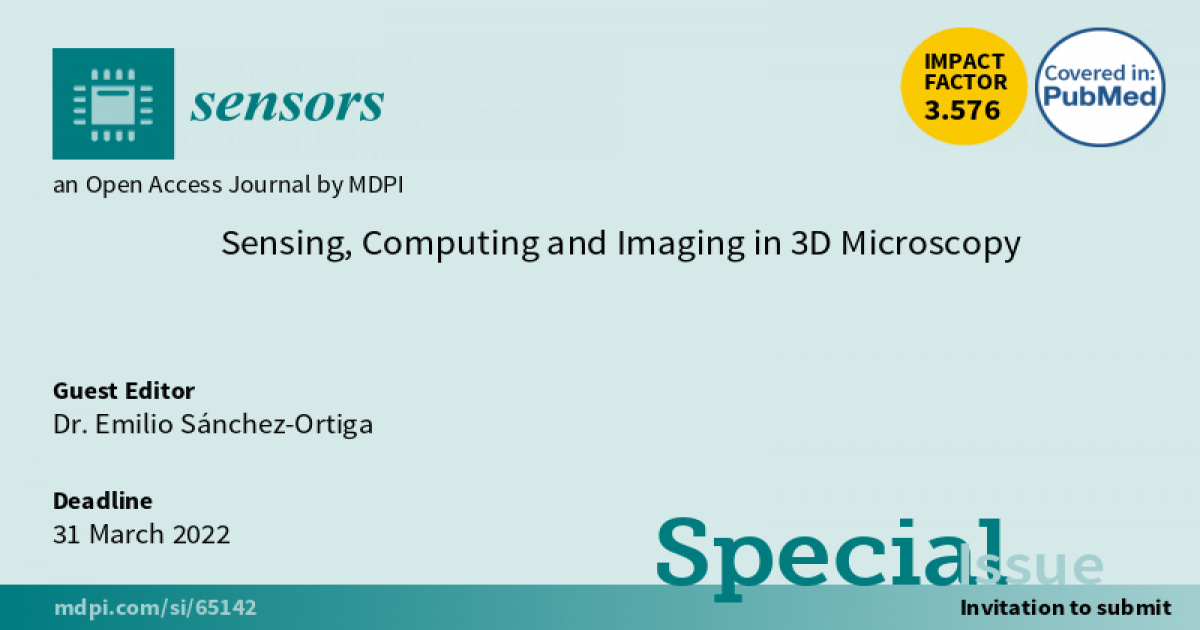- 3.5Impact Factor
- 8.2CiteScore
- 20 daysTime to First Decision
Sensing, Computing and Imaging in 3D Microscopy
This special issue belongs to the section “Sensing and Imaging“.
Special Issue Information
Dear Colleagues,
In recent years, the development of microscopy methods that exploit the use of non-conventional sensing and the power of image processing has provided a wide range of new applications in different fields, such as biomedical research, materials science, microfluidics, etc. This Special Issue is devoted to providing a general view of recent advances in 3D microscopy, highlighting methods that provide additional information about microscopic samples through non-conventional sensing approaches. For instance, superresolution techniques retrieve high-resolution information of specimens that is not attainable in a conventional microscope. Other techniques such as quantitative phase imaging or Brillouin microscopy measure the morphological properties of microscopic samples by means of conventional intensity sensors. Light-field microscopy and Fourier ptychography are based on multiplexing the spatio-angular information of the sample in the sensor plane. These techniques, among others, combine conventional optics with unique sensing and computing approaches, leading to novel paths to inspect and characterize samples.
The contributions to this Issue can be original research articles or reviews regarding the state-of-the-art of an already existing technique.
Topics may include but are not limited to:
- Quantitative-phase imaging microscopy;
- Brillouin microscopy;
- Light-field microscopy;
- Fourier ptychography;
- Superresolution microscopy;
- Optical sectioning
Dr. Emilio Sánchez-Ortiga
Guest Editor
Manuscript Submission Information
Manuscripts should be submitted online at www.mdpi.com by registering and logging in to this website. Once you are registered, click here to go to the submission form. Manuscripts can be submitted until the deadline. All submissions that pass pre-check are peer-reviewed. Accepted papers will be published continuously in the journal (as soon as accepted) and will be listed together on the special issue website. Research articles, review articles as well as short communications are invited. For planned papers, a title and short abstract (about 250 words) can be sent to the Editorial Office for assessment.
Submitted manuscripts should not have been published previously, nor be under consideration for publication elsewhere (except conference proceedings papers). All manuscripts are thoroughly refereed through a single-blind peer-review process. A guide for authors and other relevant information for submission of manuscripts is available on the Instructions for Authors page. Sensors is an international peer-reviewed open access semimonthly journal published by MDPI.
Please visit the Instructions for Authors page before submitting a manuscript. The Article Processing Charge (APC) for publication in this open access journal is 2600 CHF (Swiss Francs). Submitted papers should be well formatted and use good English. Authors may use MDPI's English editing service prior to publication or during author revisions.

Benefits of Publishing in a Special Issue
- Ease of navigation: Grouping papers by topic helps scholars navigate broad scope journals more efficiently.
- Greater discoverability: Special Issues support the reach and impact of scientific research. Articles in Special Issues are more discoverable and cited more frequently.
- Expansion of research network: Special Issues facilitate connections among authors, fostering scientific collaborations.
- External promotion: Articles in Special Issues are often promoted through the journal's social media, increasing their visibility.
- e-Book format: Special Issues with more than 10 articles can be published as dedicated e-books, ensuring wide and rapid dissemination.

